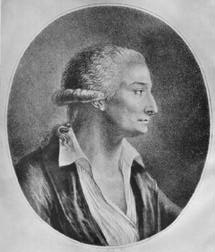| ANTOINE LAURENT LAVOISIER
[1743 – 1794] Antoine-Laurent Lavoisier,
a French chemist was born in Paris on August 1743. His father was a very prosperous lawyer.
Lavoisier received his education at the College Mazarin, where he studied language, literature
and philosophy and obtained the best training available in mathematics, astronomy,
chemistry and botany. He was expected to follow his father's footsteps and studied law.
He received his license to practice law in 1764 but decided to pursue a career in science.
In 1768, at the age of 25, he was elected to the prestigious Royal Academy of Science for his paper on improving the street lights of Paris and other works on agriculture.

Lavoisier demonstrated with careful
measurements that transmutation of water to earth was not possible. He burned phosphorus
and sulfur in air and showed that the products weighed more than the original. This was
contrary to the prevailing notion of the phlogiston theory. In the same experiment he showed that the
weight gain was equal to weight loss of air. Thus he established the Law of Conservation
of Mass.
In 1778, he showed that air is a mixture of oxygen and nitrogen and was able to estimate
that about a quarter of the atmospheric air is oxygen and three quarter is not breathable (nitrogen).
In 1783, Lavoisier demonstrated that water is not an element but composed of two gases,
oxygen and hydrogen. In Methods of Chemical Nomenclature (1787), he developed the system of chemical nomenclature. His Elementary Treatise of Chemistry (1789),
was the first modern chemistry text book, contained a clear statement of the Law of
Conservation of Mass, and denied the existence of phlogiston.
In 1794, Lavoisier was beheaded because of his involvement in Tax Farm. His colleague Lagrange
commented at his death, "It took them only an instant to cut off that head, but it is
unlikely that a hundred years will suffice to produce a similar one."
|


